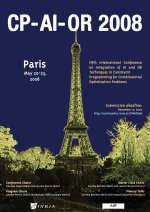The finalists for the 2008 Franz Edelman Award for Achievement in Operations Research and the Management Sciences have been announced. The Edelman Awards are a big thing in OR. The prize is given to the best use of operations research in practice. Even getting to be a finalist is a lot of work: this is not just a matter of submitting a paper and seeing how it goes. The finalists have to work even harder. They need to prepare a highly professional presentation, with the best presentations getting the support of a firm’s very top management (one year, the South African defense department was a finalist, and President Mandela provided a letter of support). Each finalists is assigned a coach to help them prepare their presentation (the late Rick Rosenthal was proud of the role he played as a coach, and I think finalists working with him may have had a bit of an advantage). And the projects have to be real, not hypothetical. Without verifiable and significant effect, a project cannot be a finalist, let alone a winner.
INFORMS has jazzed up the competition quite a bit in the last years, with fancy presentations at the Practice Meeting. I think this is great: these projects save, often, hundreds of millions of dollars, or improve many lives. They deserve a celebration.
This year’s finalists are an interesting bunch:
1. Federal Aviation Administration, for a project entitled “Airspace Flow Programs,” which gives the FAA greater ability to control the nation’s skies at times of peak consumer usage and flight congestion.
2. Netherlands Railways, for “The New Dutch Timetable: The O.R. Revolution,” a solution that improved on-time performance and capacity for more than a million daily train passengers.
3. StatoilHydro, one of the world’s largest gas producers, and Gassco, the independent Norwegian network operator, for “Optimizing the Offshore Pipeline System for Natural Gas in the North Sea.”
4. The City of Stockholm, Sweden for “Operations Research (O.R.) Improves Quality and Efficiency in Social Care and Home Help,” a program that has brought improvements to the complex scheduling of more than 4,000 providers who help the sick and the elderly.
5. U.S. Environmental Protection Agency, for “Reducing Security Risks in American Drinking Water Systems.”
6. Xerox, for “LDP Lean Document Production® – Dramatic Productivity Improvements for the Printing Industry,” which has bettered production and reduced costs for print shops and document manufacturers. The total impact to date on Xerox profits from the utilization of the LDP is about $200M. Xerox has filed 48 patents on this methodology and so far 11 have issued.
 That’s three international organizations and only one traditional manufacturing finalist. The Swedish finalist in particular represents a strong trend in OR: using OR in the service sector.
That’s three international organizations and only one traditional manufacturing finalist. The Swedish finalist in particular represents a strong trend in OR: using OR in the service sector.
I am looking forward to seeing the presentations at the Practice Meeting.
![]() Let me be late in the OR blogging game and note that there is a great article on operations research at Proctor and Gamble on bnet. It is wonderful advertising for our field, including phrases like “P&G’s Killer Apps in OR”. INFORMS was strongly involved in the article, with quotes from Past-President Brenda Dietrich and Executive Director Mark Doherty:
Let me be late in the OR blogging game and note that there is a great article on operations research at Proctor and Gamble on bnet. It is wonderful advertising for our field, including phrases like “P&G’s Killer Apps in OR”. INFORMS was strongly involved in the article, with quotes from Past-President Brenda Dietrich and Executive Director Mark Doherty:
 That’s three international organizations and only one traditional manufacturing finalist. The Swedish finalist in particular represents a strong trend in OR: using OR in the service sector.
That’s three international organizations and only one traditional manufacturing finalist. The Swedish finalist in particular represents a strong trend in OR: using OR in the service sector. Andy Boyd, formerly chief scientist of
Andy Boyd, formerly chief scientist of  Also, Andy has a new book out on pricing entitled
Also, Andy has a new book out on pricing entitled  I am co-program chair for CP-AI-OR 2008 to be held in May in Paris. This year, we decided to allow “short papers” primarily to encourage presentation of preliminary work or work that might have appeared in another outlet but would still be of interest to the CP-AI/OR community. If you aren’t familiar with CP-AI/OR, it is a small (roughly 100 person) conference that brings together people in constraint programming and operations research to discuss issues in common in the two field (I actually put constraint programming as part of operations research, but most constraint programmers don’t agree with me).
I am co-program chair for CP-AI-OR 2008 to be held in May in Paris. This year, we decided to allow “short papers” primarily to encourage presentation of preliminary work or work that might have appeared in another outlet but would still be of interest to the CP-AI/OR community. If you aren’t familiar with CP-AI/OR, it is a small (roughly 100 person) conference that brings together people in constraint programming and operations research to discuss issues in common in the two field (I actually put constraint programming as part of operations research, but most constraint programmers don’t agree with me).